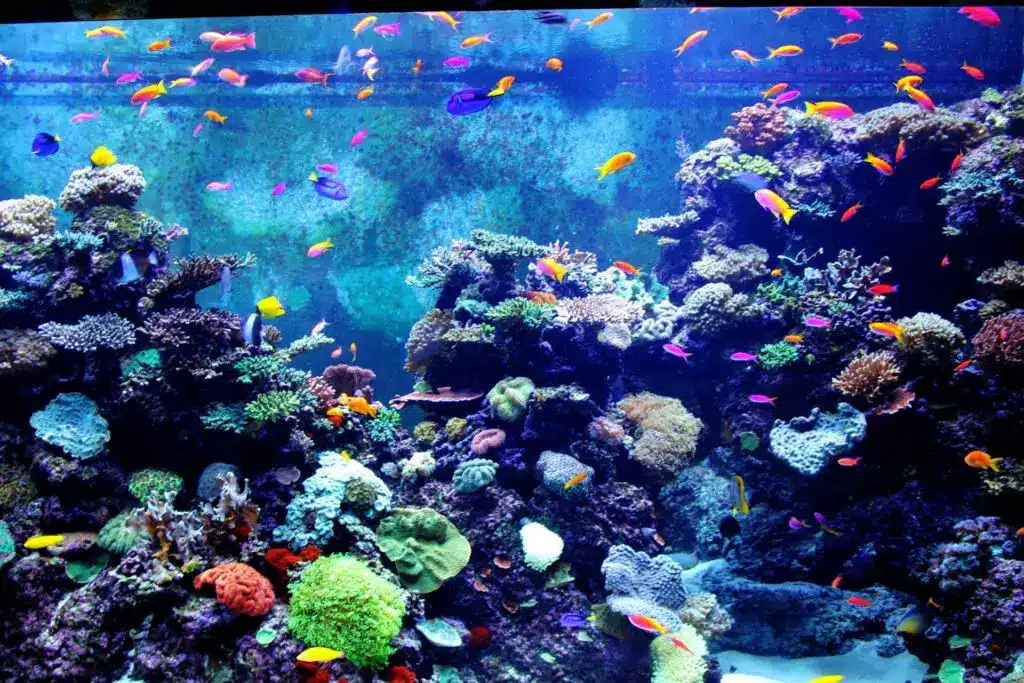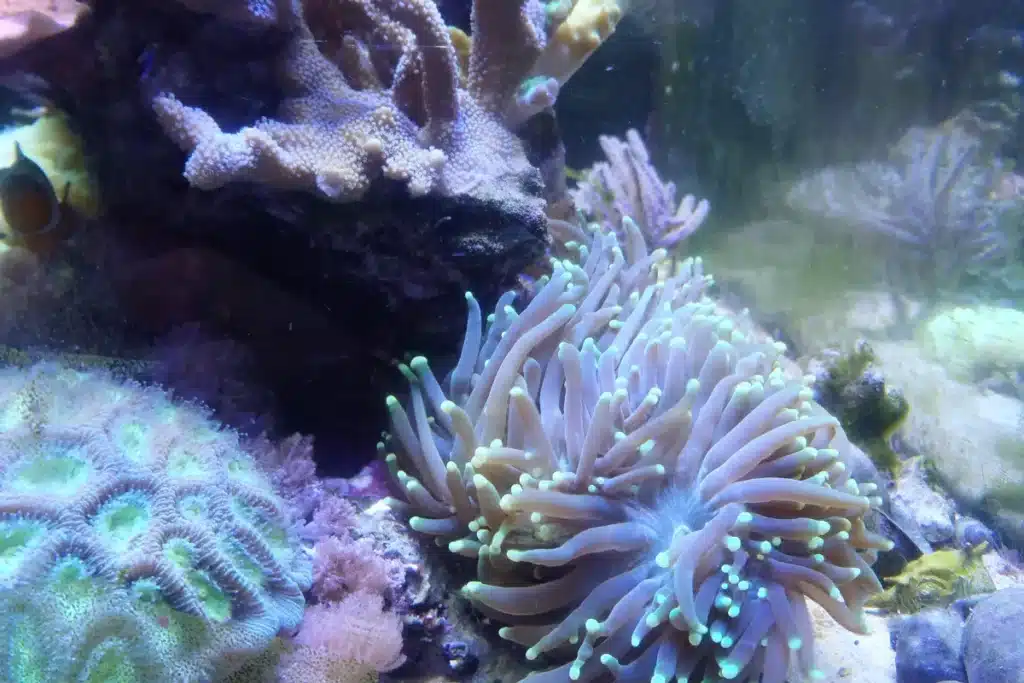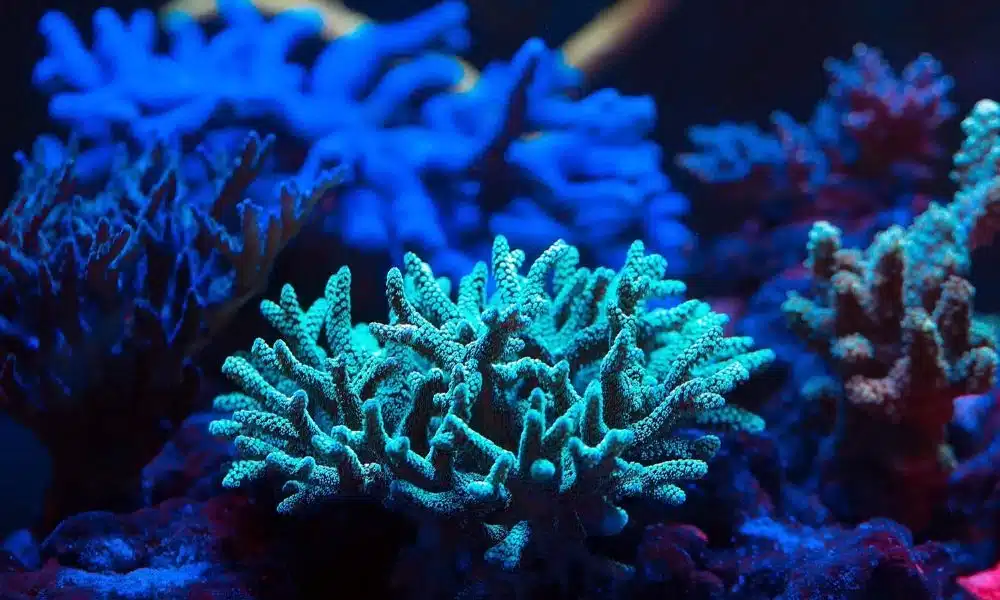Do Corals Need White Light

Introduction
Do Corals Need White Light: Coral reefs are among the most biodiverse ecosystems on our planet, providing a habitat for a myriad of marine species. Central to the health and vitality of these ecosystems is the symbiotic relationship between corals and photosynthetic microorganisms called zooxanthellae. This partnership allows corals to thrive in nutrient-poor tropical waters. However, a critical question arises: do corals need white light to sustain this essential relationship and their overall well-being?
Light is an indispensable factor for corals, as it serves as the primary energy source for the photosynthesis carried out by their zooxanthellae. While light is unquestionably essential, the type of light corals require has sparked debate among marine scientists.
White light, composed of all visible colors in the spectrum, is often used in aquariums to illuminate coral colonies. Yet, coral reefs in their natural habitat receive a more nuanced light spectrum influenced by factors like depth and water quality. This raises intriguing questions about whether white light is truly optimal for coral health or if specific wavelengths might better support their photosynthetic needs.

Does a reef aquarium need white light?
Even though some tanks might look white and some tanks look really blue, a reef tank light still needs to be supplying that full spectrum of light with spikes in the UV, purple, and blue wavelengths.
A reef aquarium’s lighting is a critical factor in the health and vibrancy of the coral and marine life within it. While white light can be beneficial, it’s not the only requirement. Reef aquariums primarily need a balance of different light spectrums to mimic natural sunlight and support the diverse photosynthetic needs of corals and other organisms.
It enhances the colors of corals and fish, allowing for a visually appealing display. However, it’s the combination of blue and actinic lighting that is equally if not more crucial for the well-being of reef inhabitants.
While white light is essential for an attractive reef tank, it should be complemented by the right balance of blue and actinic light to support the photosynthetic processes crucial for the health and sustainability of the delicate ecosystem within a reef aquarium. Achieving this balance ensures not only a beautiful display but also the well-being of the aquatic life it houses.
What is the best lighting for coral reefs?
Light Emitting Diodes (LED) The most popular type of lighting fixture in the reef aquarium hobby is LED. LED fixtures are nice because they offer the most in terms of control, are energy efficient, and the LEDs themselves are long-lasting.
The best lighting for coral reefs is a carefully balanced combination of different light spectrums that mimic natural sunlight. Reef enthusiasts and aquarists commonly use LED fixtures, T5 fluorescent bulbs, or metal halide lamps to achieve this balance. Key considerations for the best lighting for coral reefs include:
- Spectrum: A full spectrum of light is essential, including blue, violet, and ultraviolet (UV) wavelengths. Blue light, in particular, is crucial for the photosynthetic processes of zooxanthellae.
- Intensity: Coral reefs require high-intensity lighting, as they thrive in shallow waters where sunlight is strong. Adequate light penetration ensures that corals receive the light they need to grow and maintain their vibrant colors.
- Controllability: Modern LED fixtures allow for precise control over the light spectrum, intensity, and photoperiod. This flexibility enables aquarists to create custom lighting schedules that simulate natural conditions and promote coral health.
- Heat Management: Some lighting sources, like metal halides, can generate a significant amount of heat. Proper heat dissipation or cooling systems are necessary to maintain a stable temperature in the aquarium.
- Energy Efficiency: LED lighting is often preferred for its energy efficiency and long lifespan, reducing operational costs and environmental impact.
Ultimately, the best lighting for coral reefs depends on the specific needs of the coral species in the aquarium and the preferences of the aquarist. Regular monitoring of water parameters and the coral’s response to the lighting can help fine-tune the setup for optimal growth and coloration.
What color light do corals need?
Blue spectrum
Efficient photosynthesis requires not only adequate light intensity but also the correct spectrum of light. Terrestrial plants, like those found in our garden, favor colors in the yellow, orange, and red range while corals favor colors in the blue spectrum.
Corals require a specific range of colors of light to thrive, with blue light being the most essential. Blue light in the range of 400-500 nanometers is crucial because it corresponds to the peak absorption spectra of the photosynthetic pigments, such as chlorophyll and carotenoids, found in the symbiotic algae known as zooxanthellae that live within coral tissues.
These zooxanthellae are responsible for providing corals with essential nutrients through photosynthesis. When blue light is absorbed by these pigments, it triggers the photosynthetic process, allowing corals to convert light energy into food and energy for growth.
In addition to blue light, corals also benefit from other colors in the light spectrum, including violet and ultraviolet (UV) light. These wavelengths can enhance the photosynthetic efficiency of zooxanthellae and promote the production of pigments that give corals their vibrant colors.
While corals do benefit from some white light for visibility and aesthetics, a significant portion of white light also contains blue wavelengths, making it a suitable choice for most reef aquariums. However, it’s crucial to ensure that the spectrum of the lighting system closely matches the natural conditions of coral reefs, providing the right balance of colors, intensity, and photoperiod to support the health and growth of these fascinating marine organisms.
Does white light affect coral?
Too much white will increase algae growth. Corals get most of their needed photosynthetic radiation from 420-460nm which is the blue spectrum. White is mostly a preferential thing and not as important to coral growth though some white is beneficial.
White light can affect coral in both positive and negative ways, depending on the intensity and duration of exposure. White light, which includes a full spectrum of colors, is often used in reef aquariums for aesthetic purposes and visibility. However, its impact on corals is complex and requires careful management.
Positive Effects:
- Growth and Health: White light provides the necessary intensity for photosynthesis in the zooxanthellae living within coral tissues. This process is essential for coral growth and overall health.
- Coloration: White light enhances the vivid colors of corals, making them visually appealing in reef aquariums. It can also reveal the true colors of corals, which might be masked under specialized lighting.
Negative Effects:
- Excessive Light: Too much white light, especially when coupled with high-intensity lighting, can lead to photoinhibition, causing stress to corals. This stress can manifest as bleaching, where corals expel their symbiotic algae, potentially leading to coral death.
- Algae Growth: White light can promote the growth of unwanted algae in the aquarium, which can compete with corals for nutrients and space.
To maximize the benefits of white light while mitigating potential harm, reef enthusiasts often use a combination of white light with blue and actinic lighting, closely simulating natural sunlight. They also carefully control the intensity and duration of lighting, as well as monitor water parameters to ensure optimal conditions for coral growth and well-being.
How do I know if my corals are getting enough light?
Corals like the ones we added in these tanks will often show signs of not enough light by stretching out and reaching for the light as well as gradually turning brown. Corals receiving too much light will shrink up, retract polypes, bleach white or close and sometimes start to loose tissue.
Determining whether your corals are receiving adequate light is crucial for their health and growth in a marine aquarium. Here are key indicators and considerations to help you assess if your corals are getting enough light:
- Coral Appearance: Observe the coloration and overall appearance of your corals. Healthy corals typically exhibit vibrant colors and polyp extension during the day when they’re actively photosynthesizing. Faded colors, retracted polyps, or signs of stress could indicate insufficient light.
- Growth Rate: Measure the growth of your corals over time. Healthy corals should be steadily growing. Slow or stunted growth might suggest inadequate light levels.
- Light Intensity: Invest in a reliable light meter to measure the intensity of light in your aquarium. Compare the readings to the specific light requirements of your coral species, as different corals have varying needs.
- Light Spectrum: Ensure that the light spectrum you’re using includes the necessary wavelengths for coral photosynthesis. Corals primarily utilize blue and red light, so a spectrum that includes these colors is crucial.
- Duration and Consistency: Maintain a consistent light schedule, mimicking natural day-night cycles.
- Positioning: Pay attention to the placement of your corals within the aquarium. Some corals have specific light requirements, such as high or low light, and should be positioned accordingly.
Regular monitoring and adjustments based on the observations above will help ensure that your corals receive the appropriate amount and quality of light to thrive in your aquarium environment.
Do corals need white light to thrive?
Corals, particularly the hard corals that build coral reefs, have a mutualistic relationship with photosynthetic algae called zooxanthellae. These algae reside within the coral’s tissues and provide them with essential nutrients through photosynthesis. Light is a fundamental factor for photosynthesis.
However, the natural lighting conditions on coral reefs are not purely white light. The spectrum of light underwater is influenced by depth, water quality, and the angle of the sun, resulting in a shifting blend of colors. Corals have adapted to these changing conditions over millennia.
However, recent research suggests that corals may benefit from more targeted light spectrums, such as those rich in blue and red wavelengths, which are particularly effective for photosynthesis.
While corals do require light for their survival and well-being, the question of whether they specifically need white light is complex. Providing a spectrum that mimics the natural lighting conditions of their habitat, with a focus on the wavelengths essential for photosynthesis, may be more beneficial for their long-term health and growth in aquariums.
Can corals survive with only white light?
While corals can survive with white light, it may not be the most efficient choice for their growth and coloration. White light contains all visible wavelengths, but it may lack the intensity and spectrum specificity that corals need for optimal photosynthesis and pigment production.
Corals can survive with white light, but it may not be the optimal or ideal lighting condition for their long-term health and growth. Corals have evolved to thrive in their natural habitats, where the underwater light spectrum is more diverse and varies with depth, water quality, and time of day.
Corals have a symbiotic relationship with photosynthetic algae called zooxanthellae, which rely on specific wavelengths of light, including blue and red, for efficient photosynthesis. While white light includes these wavelengths, it also contains other colors that may not be as essential for photosynthesis. This means that corals exposed solely to white light may not receive the most efficient light for their metabolic processes.
While corals can survive under white light, it is advisable to consider their specific light requirements, including the wavelengths that best support their photosynthetic processes, to ensure their long-term well-being and growth in a controlled environment like an aquarium.
How can I determine if my corals are receiving adequate light?
Determining whether your corals are receiving adequate light is crucial for their health and growth in a reef aquarium. Adequate light ensures that your corals can photosynthesize, which is vital for their energy production and coloration. Here are some key methods to help you assess if your corals are getting the right amount of light:
- Visual Inspection: Observe the appearance of your corals. Healthy corals should exhibit vibrant colors and extend their polyps during the day. Faded colors, closed polyps, or signs of bleaching can indicate insufficient light.
- Light Intensity: Use a PAR (Photosynthetically Active Radiation) meter to measure the light intensity in your aquarium. Different coral species have varying light requirements, so research your specific corals to determine their optimal PAR range.
- Light Spectrum: Ensure that your lighting system provides a spectrum that covers the essential wavelengths for coral photosynthesis, including blue and purple light. Adjustable LED lights are popular choices as they allow you to customize the spectrum.
- Light Duration: Maintain a consistent lighting schedule. Corals generally require 8-12 hours of light per day, with some variation based on species and tank conditions.
- Light Positioning: Properly position your light fixtures to ensure even coverage throughout the tank. Shadows or areas of excessive light can stress corals.
Regular monitoring and adjustments to your lighting setup based on the specific needs of your coral species will help ensure they receive adequate light, promoting their health and vibrant appearance in your reef aquarium.

Conclusion
Instead, it becomes evident that corals have adapted to a diverse range of light conditions in their natural environments. White light, with its full spectrum of colors, remains essential to the photosynthetic processes of zooxanthellae living within coral tissues.
However, it is crucial to acknowledge that natural light conditions on coral reefs are dynamic and influenced by various factors, including depth, water quality, and time of day. Corals have evolved to thrive under these varying conditions, suggesting that a more nuanced approach to coral lighting in aquariums and conservation efforts may be beneficial.
While white light remains vital for coral health, ongoing research into the intricacies of coral-light interactions can further refine our understanding of their specific needs. This knowledge can guide more effective coral conservation strategies, ultimately helping to safeguard these extraordinary ecosystems in the face of mounting environmental challenges.



